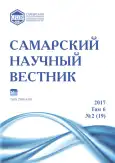Lactose-positive intestinal protozoa in objects under construction soil cover of the Samara Region
- Authors: Vorobjeva K.Y.1, Prokhorova N.V.1
-
Affiliations:
- Samara National Research University
- Issue: Vol 6, No 2 (2017)
- Pages: 27-31
- Section: 03.02.00 – General Biology
- URL: https://journals.rcsi.science/2309-4370/article/view/21791
- DOI: https://doi.org/10.17816/snv201762105
- ID: 21791
Cite item
Full Text
Abstract
Samara Region is one of the largest industrial and agricultural centers of the Russian Federation. It is characterized by a high level of urbanization. Soil degradation, its chemical and bacteriological pollution as well as declining fertility are the result of versatile economic activity in the region. The rate and level of soil pollution are actively monitored however only very scarce data on its sanitary-epidemiological condition are available. At present Samara Region is facing a boost of residential, administrative and industrial constriction which requires sanitary-epidemiological testing of soil at construction sites. The paper deals with the above mentioned problem. It has been determined that the most reliable criteria in estimating the sanitary-epidemiological condition of soil are sanitary-significant microorganisms, a group of coliform bacillus in particular. The causes and effects of urban soil pollution by microbiological contaminants have been analyzed. The role of lactose-positive intestinal protozoa as sanitary-significant microorganisms has been studied. A quantitative evaluation of lactose-positive intestinal protozoa index has been carried out for the soils below residential buildings, administrative buildings, industrial constructions as well as the utility systems area. In particular, it has been measured that the level of soil pollution by lactose positive intestinal protozoa depends on the period they have been in human use. An aggravated level of soil pollution in certain areas can be observed due to uncontrolled littering as well as pet walking or an increasing number of stray animals. Industrialized areas (oil plants) are characterized by the lowest level of lactose positive protozoa contamination which is explained by the fact that those industries use modern technologies which are able to minimize ecological risks. However, such areas are polluted in a different way. Dangerous level of soil contamination by lactose positive protozoa is registered at several large automotive plants.
Full Text
##article.viewOnOriginalSite##About the authors
Kseniya Yurjevna Vorobjeva
Samara National Research University
Email: kseniya-vorobeva-1990@mail.ru
postgraduate student of Ecology, Botany and Nature Protection Department
Russian FederationNataliya Vladimirovna Prokhorova
Samara National Research University
Author for correspondence.
Email: natali.prokhorova.55@mail.ru
doctor of biological sciences, professor of Ecology, Botany and Nature Protection Department
Russian FederationReferences
- Экология и экономика природопользования: учебник для вузов / под ред. Э.В. Гирусова. М.: Закон и право ЮНИТИ, 1998. 455 с.
- Урсул А.Д., Урсул Т.А., Иванов А.В., Машков А.Н. Экология, безопасность, устойчивое развитие. М.: Университетская книга, 2012. 320 с.
- Международный деловой портал «Инвестиции. Инновации. Бизнес» [Электронный ресурс] // http:// spb-venchur.ru/regions/78.
- Горелов М.С., Матвеев В.И., Устинова А.А. Природа Куйбышевской области. Куйбышев: Кн. изд-во, 1990. 464 с.
- Государственный доклад о состоянии окружающей среды и природных ресурсов в Самарской области за 2014 год. Самара: Изд-во СНТ, 2015. Вып. 25. 397 с.
- О санитарно-эпидемиологической обстановке в Самарской области в 2011 году: доклад / под ред. Н.М. Сергеевой. Самара, 2012. 214 с.
- Русаков Н.В. Роль почвы и отходов в заболеваемости населения // Окружающая среда и здоровье: матер. всерос. науч.-практ. конф. молодых ученых и специалистов. Суздаль, 2005. С. 16-23.
- Гигиеническая оценка качества почвы населенных мест: Методические указания МУ 2.1.7.730-99. М.: Федеральный центр госсанэпиднадзора Минздрава России. 1999. 38 с.
- Звягинцев Д.Г., Бабьева И.П., Зенова Г.М. Биология почв: учебное пособие. М.: Изд-во МГУ, 2005. 445 с.
- Игай Е.Л. Гигиена и экология человека: учебно-методическое пособие. Минусинск, 2014. 360 с.
- Оценка экологического состояния почвы: практ. руководство / под ред. А.Г. Муравьева. СПб.: Крисмас+, 2015. 208 с.
- Муравьев А.Г. Оценка экологического состояния природно-антропогенного комплекса. СПб.: Крисмас+, 2000. 39 с.
- Кондакова Г.В. Санитарная микробиология: учебно-методическое пособие. Ярославль: Изд-во ЯрГУ, 2005. 84 с.
- Инструкция по проведению инженерно-экологических изысканий для подготовки проектной документации строительства, реконструкции объектов в г. Москве. М.: Москомархитектура, 2008. 24 с.
- Корнелаева Р.П., Степаненко П.П., Павлова Е.В. Санитарная микробиология сырья и продуктов животного происхождения. М.: Полиграфсервис, 2006. 406 с.
- СанПиН 2.1.7.1287-03 Санитарно-эпидемиологические требования к качеству почвы. М.: Федеральный центр Госсанэпиднадзора Минздрава России, 2004. 23 с.
- ГОСТ 17.4.4.02-84 Охрана природы. Почвы. Методы отбора и подготовки проб для химического, бактериологического, гельминтологического анализа. М.: Стандартинформ, 2008. 8 с.
- ГОСТ 17.4.3.01-83 Охрана природы (ССОП). Почвы. Общие требования к отбору проб. М.: ИПК Издательство Стандартов, 2004. 4 с.
- Почвенная карта Куйбышевской области. М. 1:300000. М.: ГУГК, 1988.
- Колодина Л.Н., Белых Е.Н. Микробиологическое загрязнение почв города Москвы // Эл. научный журнал «Исследовано в России». 2007. С. 21-35.
Supplementary files






